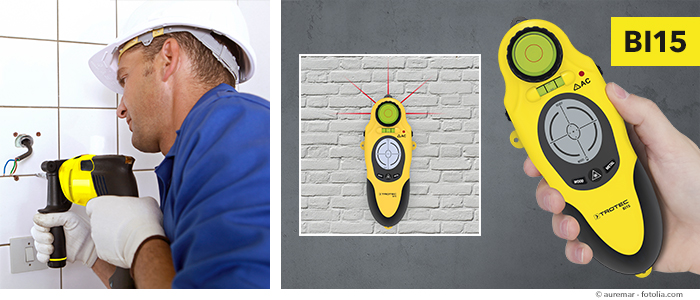 Anyone who wants to hang up mirrors and install shelves generally has to drill one or several holes into the wall. Not a problem – as long as it’s clear where exactly the power cables and water pipes running through the wall are. There is a DIN standard for this purpose – but applying this cannot be taken for granted, especially in the case of old buildings. It is therefore worth checking this with a wall scanner such as the BI15 from Trotec – because even short drill attachments can damage or even destroy cables or pipes.
Anyone who wants to hang up mirrors and install shelves generally has to drill one or several holes into the wall. Not a problem – as long as it’s clear where exactly the power cables and water pipes running through the wall are. There is a DIN standard for this purpose – but applying this cannot be taken for granted, especially in the case of old buildings. It is therefore worth checking this with a wall scanner such as the BI15 from Trotec – because even short drill attachments can damage or even destroy cables or pipes.
Anyone who wants to avoid the time-consuming and thus expensive repair of cables or pipes severely damaged through drilling would be well advised to follow the DIN standard when drilling holes in new buildings. It is more complicated in the case of old buildings: such apartments may be full of charm, but there is an underestimated element of risk as far as the arbitrary laying of cables and pipes is concerned. After all, the only standard here has long been the individual taste of the owner. But we are offering a solution for this …
Drilling in new buildings
The DIN standard above turns drilling into an easy exercise, with the wall being divided into so-called “installation zones”: all horizontal pipes and cables run through the wall at a distance of approx. 15 – 45 cm above the ground and/or under the ceiling. A greater distance of 90 – 120 cm exists in kitchens due to the particular requirements relating to kitchen appliances. Vertical pipes and cables are located in a 10 – 30 cm space next to windows and doors.
Drilling in old buildings
Over the decades, old pipes and cables have often been joined by new pipes and cables not laid according to the DIN standard – just like the old ones. Where this is the case, you should make use of detectors such as the BI15 wall scanner. You simply have to bring the pipe and cable detector up to the wall or ceiling and to the area of the desired drilling site and the device accurately notifies you by means a signal whether hidden power cables and water pipes are lying in wait.
Something which is also good to know: cables running from sockets, light switches and junction boxes are generally vertical or horizontal. So if you discover a socket in the middle of a wall, the cable associated with it is in all likelihood coming down vertically from above. And often a round protrusion can be seen underneath the wallpaper. This is a junction box, with two cables usually exiting from this, although it is often even the case that several do this. Therefore, drilling directly next to such a junction box, a switch or a socket should be avoided wherever possible.
Power cable drilled through – what happens?
If despite all precautionary measures a power cable is hit, a short circuit occurs and the fuse blows. However, this does not necessarily have to happen: if only the neutral or protective conductor has been hit, it can be the case that unpleasant consequences only occur later on. Given that a power circuit contains numerous dangers, the damage must be repaired in all cases, with this best being done by a professional electrician.
Our tip – the BI15 wall scanner preserves both your nerves and your drill
In addition to ferrous and non-ferrous metals or live cables, the multifunctional BI15 wall scanner measuring device reliably finds wooden substructures located below render, plaster or concrete. The measuring device is fitted with an adjustable laser levelling assistance to show the further course for construction or piping. Combined with the two built-in spirit levels, this laser levelling assistance can be used as an installation aid for correct angular alignment.
Wall scanner BI15 – err on the side of caution and purchase this at a bargain price!
Order the wall scanner BI15 today at our current offer price, reduced from £46.83 to just £28.08 incl. VAT. – in the Trotec shop now!

